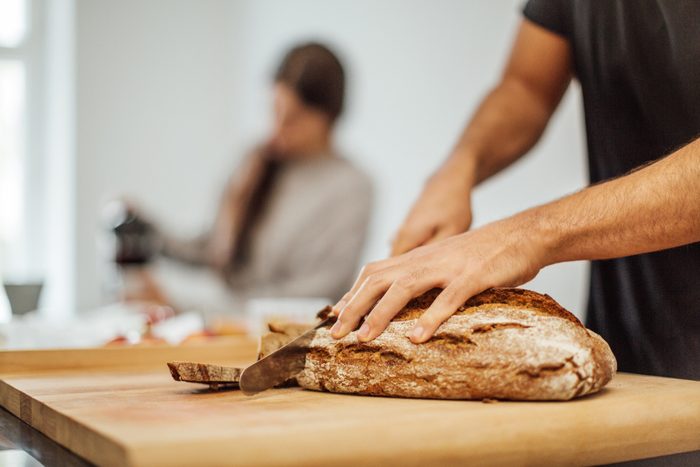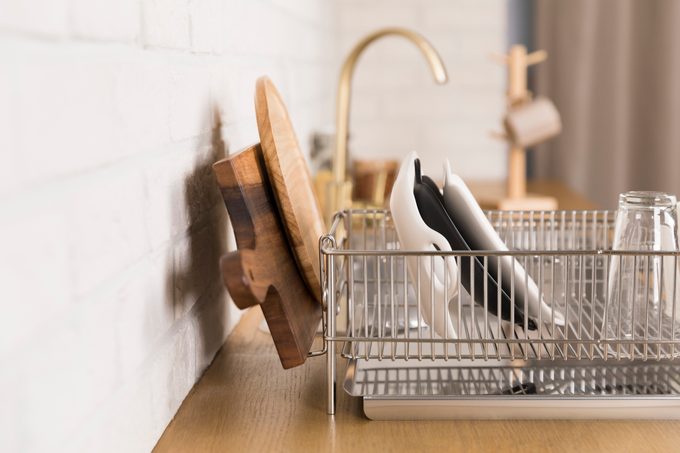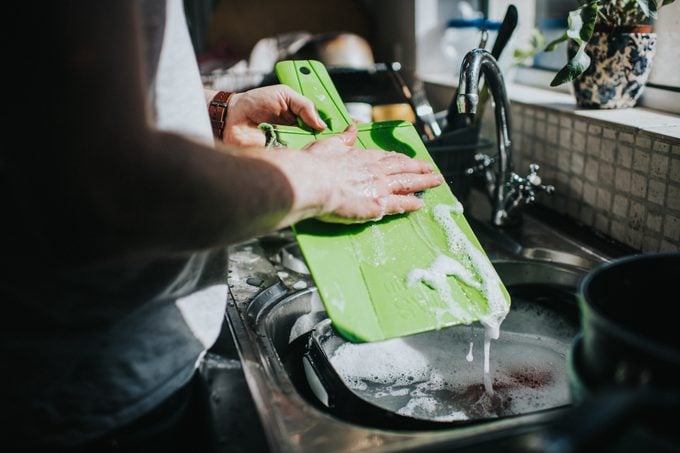How to Clean a Cutting Board
Updated: Dec. 12, 2023

There's a lot you might not know about how to clean a cutting board. Use our best tips to keep your kitchen workspace germ-free.
If you’re like us, you’re likely pulling out a cutting board at least once or twice a day for slicing bread, chopping veggies or deboning all sorts of proteins.
Cutting boards are essential, gotta-have-it foundations upon which culinary masterpieces are staged. Unfortunately, when not properly cared for, this kitchen necessity can become a breeding ground for mold and mildew, unpleasing odors, salmonella, E. coli bacteria and other yucky stuff.
Happily, you can put a wealth of simple cutting board care strategies into play to keep your surface safe, sanitized and in working order.
Types of Cutting Boards
Generally, there are three types of cutting boards: nonporous, wood and bamboo.
- Nonporous: These types are typically made of plastic, resin or glass. They don’t absorb things and are easy to clean, and they’re best for cutting up meat, poultry, and seafood.
- Wood: Think of these cutting boards as large sponges. They are likely to absorb juices from raw and cooked proteins. (Yuck!) Wooden cutting boards are best used for table-ready foods, such as herbs, vegetables, fruit, bread and cheese.
- Bamboo: Bamboo cutting boards are a more sustainable option than wooden cutting boards, and need a similar care regimen. They also are slightly harder than wood, so they’ll dull your knives more quickly.
No matter which type of cutting boards you opt for, designate one nonporous board for dissecting raw proteins (read: Friday night chicken wings) and another (whether it’s wood, plastic or bamboo) for all other chopping tasks. Learn more about why you need a separate cutting board for chicken and other meats.
Test Kitchen Tip: To make sure you grab the right board for the right task, look to purchase chopping boards in different colors. This way they’re easy to identify when you’re cooking on the fly. Chop your mango on one and your succulent pork loin on the other in this mango chutney pork roast recipe.
How to Clean a Cutting Board
When cleaning cutting boards, the objective is to remove food residue and disinfect the surfaces. There are several ways to clean and sanitize cutting boards, so choose the method you prefer (or the one you have all the ingredients and tools for already).
How to Clean a Wooden Cutting Board (or Bamboo!)

There are several options for you to choose from when it comes to deciding how to clean your wooden cutting board. No matter what, though, never wash a wood cutting board in the dishwasher, as it will absorb too much water and will be likely to warp and crack.
1. Clean and sanitize your board
To clean and disinfect at the same time, try one of these methods that make use of common household materials.
- Bleach solution: Mix 2 teaspoons of bleach with a gallon of water in your sink. Wipe down all surfaces with the bleach solution, rinse well, and stand to dry. Just like you shouldn’t run the wooden cutting board through the dishwasher, don’t soak the wooden board in the bleach solution to avoid cracking.
- Kosher salt and lemon: Scrub the board surface with kosher salt and a half of lemon to deep clean, deodorize, sanitize and remove stains. The salt acts as an abrasive, while the lemon is a natural disinfectant. Learn how to clean more with lemon.
- Vinegar with (or without) baking soda: It’s important to know how to get that garlic smell out of your cutting board! Washing your board with vinegar and hot water will remove germs and odors. For a deeper clean, sprinkle baking soda on the surface, spritz with watered-down vinegar and scrub with a brush. Remember to rinse well and stand the boards up to dry. (Psst! Here’s why vinegar is one of our favorite cleaning agents.)
2. Dry your board
No matter how you choose to wash and sanitize it, dry it with a clean towel. Set it up in a dish rack, and allow to dry for 24 hours before you put it away.
3. Condition your board every 3-4 weeks
Wood cutting boards are particularly susceptible to drying out. To prevent this, apply specialty food-grade mineral and other oils (not natural cooking oils, which can go rancid) once a month or so. The oil penetrates to saturate wood fibers, which in turns prevents unwanted liquids from seeping into the board.
Our Test Kitchen uses Boos Mystery Oil to condition, and you can too! Rub it liberally on all sides (edges included) and let it sit on the board for a few minutes. Wipe off the excess, and use the same towel to condition your bamboo boards or other smaller wooden boards at the same time.
If you don’t have the right oil on hand, try buffing the cutting board with balled-up waxed paper—and make sure you know the other clever ways to use waxed paper in the kitchen.
4. Deep condition when you notice splits or splinters
If you notice deep splits and splinters, it’s time to deep condition your wooden cutting board. Specialty creams like Boos Board Cream create barriers on board cutting surfaces and seal up cracks and knife scars that would invite in bacteria.
Similar to conditioning your board, rub the specialty cream into the board with a towel (or use your hands, like Prep Kitchen Manager Catherine Ward), but let it sit for a few hours instead of wiping off excess after a few minutes. If the cracks are very deep, wrap the board in plastic wrap after applying the cream. After letting it sit for a few days for up to a week, take off the plastic wrap and marvel at the magic—the cracks will be gone!
How to Clean a Plastic Cutting Board

When it comes to nonporous cutting boards, care is simple as can be.
1. Wash your plastic cutting board
Plastic boards are perfectly safe to put in the dishwasher, because they can withstand the water. Simply throw it into the dishwasher and set it to sanitize.
2. Sanitize your plastic cutting board
Mix up the same bleach solution that you would for wooden cutting boards, but soak the plastic cutting board in the mixture for five minutes. Rinse, stand to dry and you’ve got a clean board! This step is important to make sure to clean the grooves that come from using the cutting board get clean too—because although plastic cutting boards are nonporous, the cuts and slices in them can harbor harmful bacteria.
3. Get stains out of your cutting board
If you have pesky stains on your board, try learning how to clean a plastic cutting board with lemon to fix it. Some cooks say that by rubbing a lemon half over a stain, scrubbing with salt, and setting the plastic cutting board to sit in the sun will do the trick to bleach the stain away naturally.
When to Get Rid of Your Cutting Board
Like most often-used kitchen gear, cutting boards won’t last forever—no matter the care you give them. When cutting boards become splintered, warped, grooved or cracked, it may be time to get rid of them. (However, when it comes to wooden boards, try deep conditioning them to fix the cracks first!)
Flaws in the surface may cause knives to slip during chopping chores, which can cause more harm to you those Hasselback potatoes. If it really is time to replace your cutting board, make sure you know the best wood for cutting boards as you shop, or make it easy by opting for one of our picks for the best cutting boards you can buy.
But, when you follow our cutting board care strategies, you won’t have to consider when to replace your cutting boards any time soon. These maintenance methods ensure your boards will function fine for years, if not decades, to come. If you take good enough care of your boards, you can use your cutting boards not only for chopping but also as a place to display your charcuterie.
